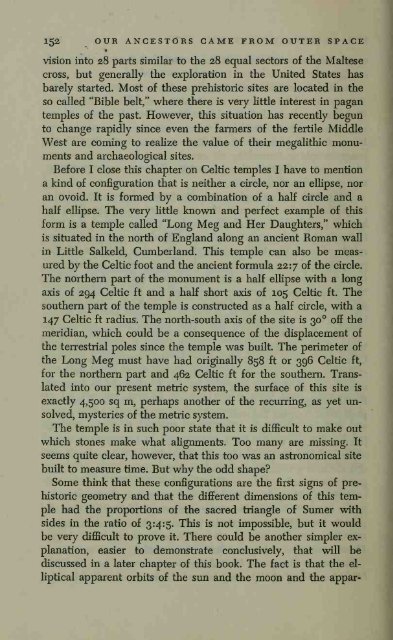You also want an ePaper? Increase the reach of your titles
YUMPU automatically turns print PDFs into web optimized ePapers that Google loves.
152 OUR ANCESTORS CAME FROM OUTER SPACE<br />
vision into 28 parts similar to the 28 equal sectors of the Maltese<br />
cross, but generally the exploration in the United States has<br />
barely started. Most of these prehistoric sites are located in the<br />
so called "Bible belt," where there is very little interest in pagan<br />
temples of the past. However, this situation has recently begun<br />
to change rapidly since even the farmers of the fertile Middle<br />
West are coming to realize the value of their megalithic monuments<br />
and archaeological sites.<br />
Before I close this chapter on Celtic temples I have to mention<br />
a kind of configuration that is neither a circle, nor an ellipse, nor<br />
an ovoid. It is formed by a combination of a half circle and a<br />
half ellipse. The very little known and perfect example of this<br />
form is a temple called "Long Meg and Her Daughters," which<br />
is situated in the north of England along an ancient Roman wall<br />
in Little Salkeld, Cumberland. This temple can also be measured<br />
by the Celtic foot and the ancient formula 22:7 of the circle.<br />
The northern part of the monument is a half ellipse with a long<br />
axis of 294 Celtic ft and a half short axis of 105 Celtic ft. The<br />
southern part of the temple is constructed as a half circle, with a<br />
147 Celtic ft radius. The north-south axis of the site is 30° oflF the<br />
meridian, which could be a consequence of the displacement of<br />
the terrestrial poles since the temple was built. The perimeter of<br />
the Long Meg must have had originally 858 ft<br />
for the northern part and 462 Celtic ft<br />
or 396 Celtic ft,<br />
for the southern. Translated<br />
into our present metric system, the surface of this site is<br />
exactly 4,500 sq m, perhaps another of the recurring, as<br />
yet unsolved,<br />
mysteries of the metric system.<br />
The temple is in such poor state that it is diflBcult to make out<br />
which stones make what alignments. Too many are missing. It<br />
seems quite clear, however, that this too was an astronomical site<br />
built to measure time. But why the odd shape?<br />
Some think that these configurations are the first signs of prehistoric<br />
geometry and that the different dimensions of this<br />
temple<br />
had the proportions of the sacred triangle of Sumer with<br />
sides in the ratio of 3:4:5. This is not impossible, but it would<br />
be very difficult to prove it.<br />
There could be another simpler explanation,<br />
easier to demonstrate conclusively, that will be<br />
discussed in a later chapter of this book. The fact is that the elliptical<br />
apparent orbits of the sun and the moon and the appar-

















